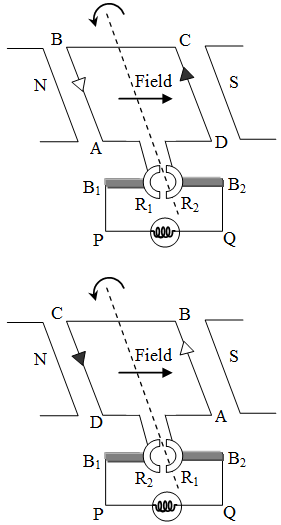What is the Working Principle of DC Generator
What is DC generator
Working Principle of DC generator: A DC generator stands for direct current electric generator. A DC generator produces direct current. A DC generator is also called DC dynamo. A simple DC generator diagram is shown in fig.

Construction of DC generator | Working Principle of DC generator
A simple DC generator consists of a coil of insulated copper wire. The coil is placed between the two poles of a strong horseshoe magnet. In actual practice, a large number of turns of the insulated copper wire are wound on a soft iron core.
The two ends of the coil are connected to the two halves of a split ring (R1, R2 called commutator). Two carbon brushes press against the two half–rings lightly. The current is taken out through the brushes B1 and B2.
People also ask related to Working Principle of DC generator
- What is the electromagnetic induction?
- What is Faraday’s law?
- What are the laws of electromagnetic induction?
- What is Lenz’s law of electromagnetic induction?
- What is alternating current and direct current?
- What is the Working Principle of AC Generator?
- What is the Principle of DC Motor?
- What is magnetic force on a current carrying conductor?
- What is the Meaning of Magnetic Force?
- What factors affect the strength of an electromagnet?
- What is the Magnetic Field?
- What Is Magnetic Effect Of Electric Current?
- Oersted Experiment on Magnetic Effect of Current
- How do you Determine the Direction of the Magnetic Field?
Working Principle of DC generator
Let the coil ABCD be initially in the horizontal position, and be rotated anticlockwise. When the coil is rotated anticlockwise, the arm AB moves downwards and the arm CD moves upwards.
The coil during this motion cuts the magnetic lines of force and an induced current is produced in the coil. According to Fleming’s right hand rule, during the downward motion of the arm AB, the induced current flows from B to A in the arm AB, and from D to C in the arm CD. The current so produced is taken out through the two half–split rings, and the carbon brushes.
After half the rotation (rotation through 180º), the arms of the coil interchanged their positions; the arm AB comes to right and the arm CD to the left. Then the arm CD starts moving downwards, and the arm AB upwards. During this half–rotation, the induced current flows from C to D in the arm CD, and from A to B in the arm AB.
The two half–split rings (R1 and R2) rotate with the coil and touch the two carbon brushed (B1, B2) one by one. As a result, each carbon brush continues to have the same polarity, (+ or –). The brush B2 always remains positive (+) terminal, and the brush B1 remains negative (–) terminal. The current so produced is called direct current (DC).
DC generator differ from an AC generator
The basic design of AC and DC generators is similar. The two generators differ only in the design of slip rings at the ends of the coil wire. An AC generator use two full rings called slip rings, one at each end of the coil wire, while an DC generator has two half–rings (called split rings) of a commutator.